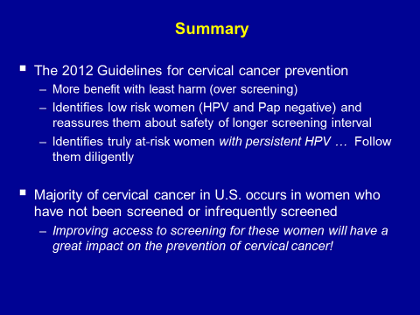Berman - Figure 24 - Summary Text
Berman - Figure 24 - Summary
In summary, the 2012 Guidelines for Cervical Cancer Prevention are meant to create improved screening, greater benefit, and less harm.
- We don’t want to over screen. I know it takes some time to become comfortable because it is a much easier to take a Pap than to explain why you are not taking a Pap.
- The guidelines identify low-risk women, and we can tell women that are Pap and HPV negative, “You have virtually no risk of disease on your cervix, you do not have HPV by a test that approaches 100% accuracy. In turn, we may safely lengthen your screening interval, and say, “But don’t forget to come in every year, because there is so much else that I need to see you for regarding your health.”
- The new Guidelines then allows us - with preferred co-testing in women age 30 and older - to identify those women who are truly at risk:
- Those with persistent HPV, i.e., those who have HPV on a second round of screening.
- If that occurs, we will follow them closely, do a cervical colposcopy, and carefully monitor them as long as they remain
HPV positive.
An important fact is that the majority of cervical cancer in the United States occurs in women who have never been screened or infrequently screened. Improving access to screening for those women will have a great impact on cervical cancer prevention.
So thank you so much for your attention.
